ADHD in the classroom is a hot topic.
Is it over-diagnosed? Are kids forced to sit too long during the school day? Both of these may be true, but today I’m going to focus on solutions – real strategies you can use.
Whether or not a child has an ADHD diagnosis…
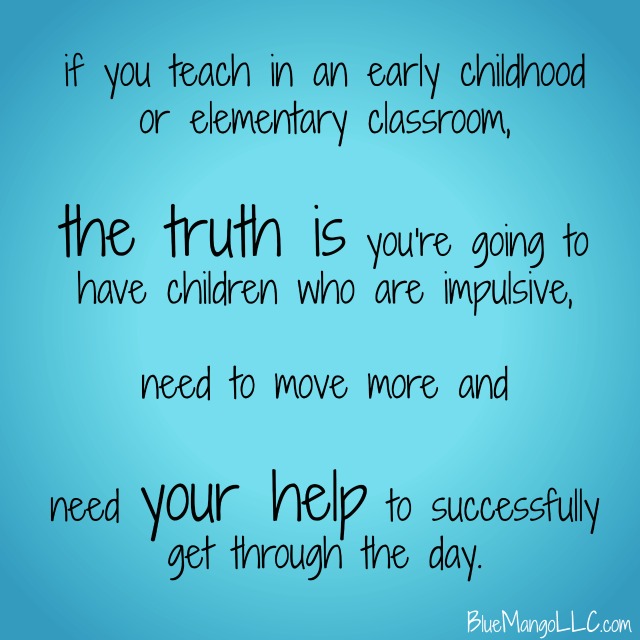
Most of the kids I’ve worked with haven’t been diagnosed with ADHD. My philosophy is that the things we do for children with learning disabilities and special needs are usually just best practice for typically developing kids.
You don’t need a label to receive the best research-based instruction and creative intervention strategies.
Today’s kids are getting less outdoor free play, more screen time (did you know the average kid spends 7.5 hours outside of school on a screen?!) and ever increasing academic demands at school.
We cannot expect kids to sit for unlimited hours on the rug or at their tables doing work – but we do need them to feel physically and emotionally regulated so that they are able to attend to the lessons that we’re teaching.
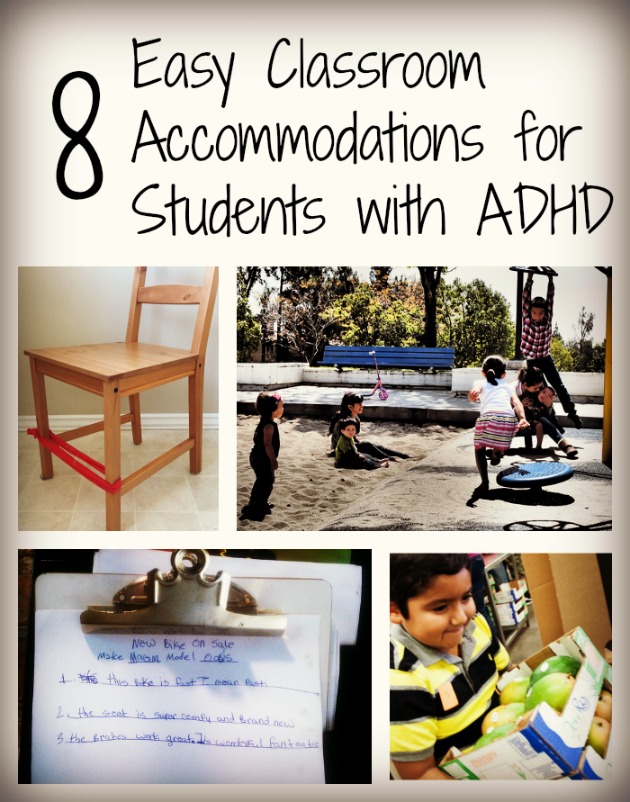
8 Easy accommodations for students with ADHD
So here are some of the most effective strategies I’ve used help children in the classroom! I’ve saved my favorite for last.
1. Give flexible work locations

Giving students control and the freedom to move around during work times can have a huge impact.
Instead of forcing active students to sit still in chair with their feet on the ground, allow them to stand, kneel, use a clipboard on the floor or move to another designated spot in the classroom such as an empty table or a stool at a counter.
This not only allows them to move around and work in a position they feel comfortable in, but helps keep them focused by moving them away from other students who may be a distraction or temptation to play with.
2. Put a rubber band around chair legs
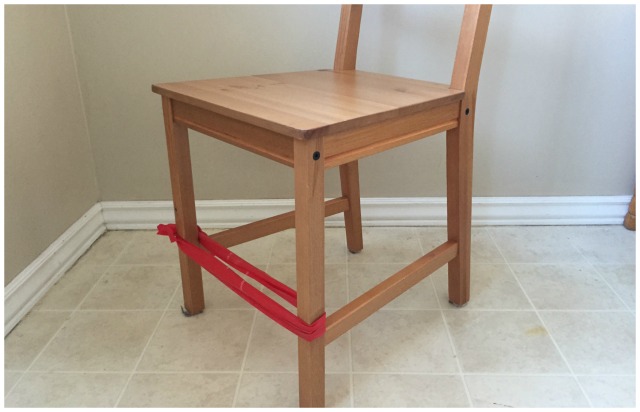
This gives kids who need to move or fidget something to do in their seats. It keeps their hands free and allows them to stay focused on their work. It’s quiet and not disruptive.
If you don’t find something productive for kids to do who need to move – they will find something else to do and it’s usually not what you want.
Instead of tapping a pencil, flicking things across the room, kicking others under the table or poking their neighbor, students can kick or bounce their feet on the rubber band.
You can buy bands that are especially made for this purpose or improvise – since my husband’s a runner we have plenty exercise resistance bands in our house.
3. Run a few laps outside
This is probably one of the most effective strategies you can use for a child whose energy is bubbling over, though it takes some creativity to implement if you are the only adult in the classroom.
It’s as simple as this – take the child outside and let him or her run.
Notice the signs:
I’ve been really impressed over the years at the ability of my 5 and 6 year olds to articulate when they are feeling out of control. A good social emotional curriculum will teach kids to identify and describe a feeling, “My engine is running too fast right now.”
Whenever a child tells me something like this, or I start to notice the signs – jumping around in line, talking nonstop, unable to stop touching the classmate closest to them, I whisk them away for a quick workout.
If you’re the only adult:
I’ve been very fortunate to always work with another teacher in the classroom so it was easy for me to take the child outside and run a few laps of the playground.
Option A: If you don’t have that option, consider asking another teacher whose kids you know are at specials. Have the child take a note over to the teacher with your request.
Option B: If the children are on their way back from a special, ask the specialist to walk the rest of your class back to the room while you quickly take the child outside.
While teachers get precious little free time during the day to set up the next lesson or go to the bathroom, most teachers care enough about kids that they will take 5 minutes out of their day to help them out.
Option C: Lastly, take the whole class out for a quick run around the playground – everyone will benefit!
4. Rethink seating arrangements on the rug
As a teacher, I was constantly rearranging where and how students sat on the rug during instruction time. For students who are impulsive and need to move a lot, a well-thought out rug spot can really help them focus and cut down on classroom disruptions.
Some kids do well with a corner spot on the outside of the rug. This allows them more space to move around without disturbing others and gives them easy access to get up off the rug if they need a break.
I had one student who did almost a full jumping jack off the rug every time he raised his hand. Having him in a corner with some space between his neighbors made this less disruptive. How could I curb that enthusiasm? His body was obviously craving to move in that way and telling him to sit still would have only been detrimental.
Other options include sitting in a chair at the back of the rug or having the child sit close to you or another teacher. You can play with my scarf or bracelet all you want as long as you’re paying attention and not disrupting anyone else!
5. Assign them as a leader
The amazing thing about students with ADHD is that they are often incredibly focused and engaged when they are able to be in control and pursue something they are passionate about.
The best thing you can do for this type of child is allow them to be a leader.
It gives them an opportunity to take responsibility, help out and use patience with others and most importantly – use their energy in a positive way.
These students are often finished with their work before others – even after you’ve had them go back and fix some careless errors made by rushing – so put them to work!
One afternoon we were wrapping gifts that the kindergartners had made for their family members. I was calling students over one by one to help instruct them in how to wrap their presents.
One boy was finished his other work early and had nothing to do – I knew he would soon be distracting his friends or doing cartwheels across the room. So I showed him the intricate steps of folding the paper, holding it down and putting just the right amount of tape in certain areas to wrap the present.
I then left him in charge of calling students over and leading them one by one in the wrapping of their presents. While it was hard for him not to do it for them, I’ve never seen him so focused, patient and proud as when he was teaching his classmates.
6. Teach wall push-ups
It’s so important to help children be aware of their energy and emotions and give them a toolbox of strategies they can implement themselves.
While structured whole class songs and movement activities are a great break in the middle of a lesson – Tony Chestnut is my all time favorite – it’s important for kids with ADHD to have some additional tools they can pull out at anytime.
Students can get some quick proprioceptive input and energy out in the classroom by doing simple exercises that last less than a minute like wall push-ups or jumping jacks.
Even stretching out exercise resistance bands is a great activity – just make sure they don’t become a slingshot!
7. Start the day outside
This may not be any option for many teachers – as I’ve mentioned before one principal refused to let me take my K/1st grade class outside for more than 20 min out of their extended school day of 8am-4pm.
But if you have any flexibility or control over your schedule, it’s seriously worth giving this a try.
Young kids usually come into the classroom at 8am bright-eyed and bushy-tailed. Give them the opportunity to chat with their friends (or you), run, throw themselves on the ground and yell before they have to sit still, be quiet and follow directions.
Just think about how great it feels to get in a short workout before you head to work. You’ve got some good mood enhancing chemicals flowing in your brain, are more energized and less stressed.
Start your students’ morning on a positive note and you will reap the benefits throughout the rest of the day.
8. Carry heavy objects to another classroom
This is my all time favorite strategy for kids who have too much energy in the classroom and are in need of some heavy work.
Fill a crate or box with some heavy books – anything the child can safely carry that’s of substantial weight will do. Tell the child that another teacher in the building needs these materials and that you need him or her to take the box over for you.
I’ve never had a child say no to leaving class and doing something special!
Clue in the other teachers in your building so they aren’t surprised when one of your students shows up at their classroom with a box of things they don’t need! For an additional challenge to your student, choose a buddy teacher that’s up a flight of stairs.
If the child cannot read yet, it’s easy to communicate to the other teacher without prior warning what’s happening by scribbling a post-it note, “Adam needed some heavy work. I’ll come and get the books back later. Thanks!”
The child comes back to class having a physical and mental break from the classroom. They forget about who was poking them on the rug and are much more likely to get settled back into their work.
Keep trying new strategies, collaborate with your fellow teachers and bring out the best in your students
All students are different so just remember one strategy may work really well with one individual and bomb with another. Keep trying different accommodations until you find what works for your particular child.
It’s also important to remember that the other teachers in your school can be really helpful. Teaching doesn’t have to be an island.
You never know when you may need to call on someone else and have them drop everything on a moment’s notice – and you would do the same for them. A great relationship with your fellow colleagues is essential!
In the context of the rigid expectations of the classroom, students with ADHD are often seen as having issues that need to be fixed – and their confidence suffers.
Adults need to focus on not forcing kids to fit into a certain mold, but on putting students in the right environment to allow their strengths to really shine.
What has worked for you?
These are just a few of the things I’ve used in my classroom to help out my kids. What strategies have you used in your classroom (or even at home) that you’ve found extremely helpful?
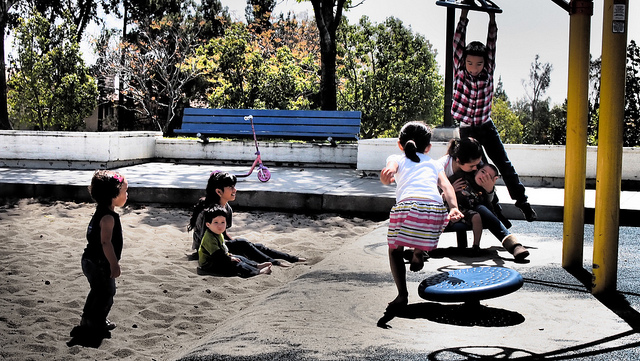
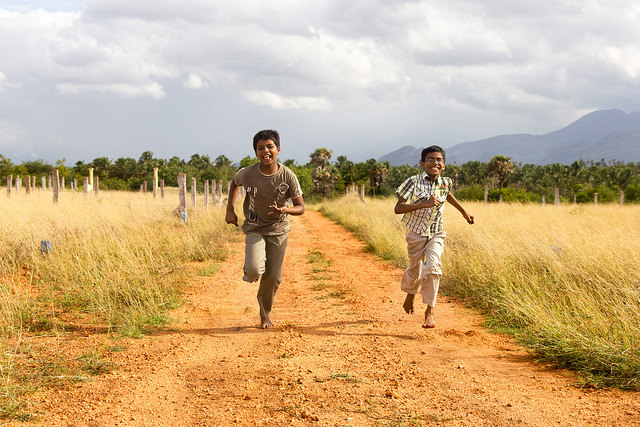
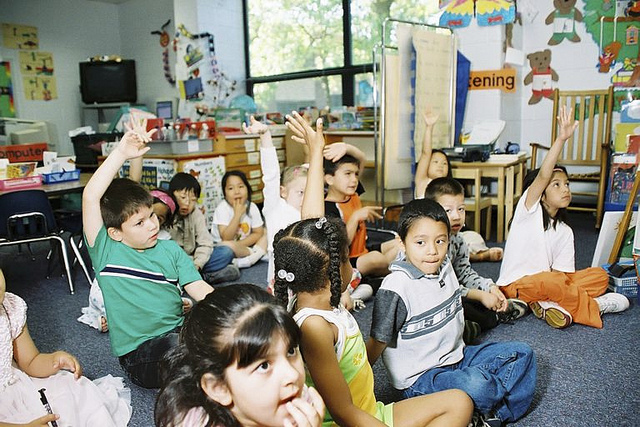
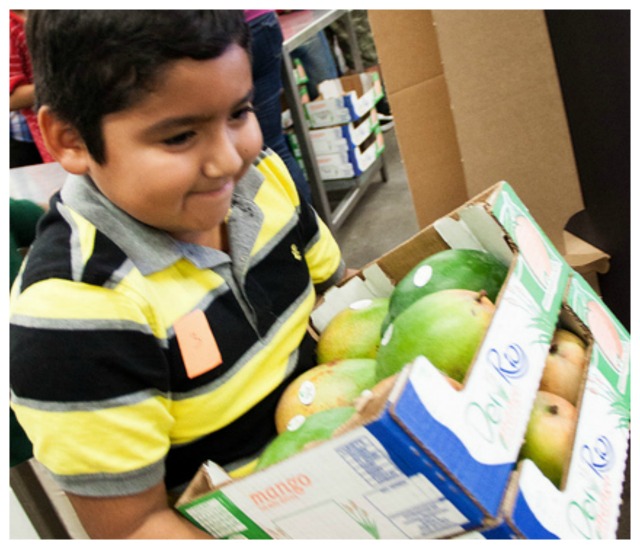
Such a great practical post & it is reassuring to see so many of the things I try to do with my class of 3-4 year olds; I am on the right track! So glad to have found your wonderful blog.
Thanks Kierna! Sometimes all it takes it a good reminder to make sure you’re on the right track with your kiddos. Sounds like you’re doing some great things!
We have used standing desks very effectively. A couple of desks are placed in the back of the room and any child needing to stand for just a few minutes is allowed to go back to the standing desk (really–just a regular student desk set on it’s highest setting!) and stand up to complete tasks. I find that even our non-adhd students sometimes just need to get up for a few moments and will occasionally use the desks.
That’s great Diane! Just a simple accommodation can make such a big difference! I always found with Kindergartners that if they weren’t being disruptive and were doing their work it was pointless to force them to sit.
Thanks for the one about resistance bands. I heard about this but didn’t know how to implement it. Also I had it in my mind that the band went on the table legs… I’ve accumulated quite a few bands, and intend to try this with the children this year.
You can use PVC pipes and tie your bands directly above them to keep them from sliding down if you want to DIY. You can buy bands for chairs or desks!
What level of resistance bands do you use? I have a few fifth and sixth graders that I would like to try these with.
Hi Mandy! Whatever you have access to. I used the lowest level of resistance (red) but work with younger elementary students. For you, I would suggest starting at more of a medium level of resistance and adjust from there. Different kids might like different amounts of resistance so you just have to play around. I’d be interested in hearing about what you discover as you test this out with your students!!
I allow for movement throughout. Everyone shares communal crayons, markers, etc. Students are allowed to get only, one at a time, so they have to get up to get the next colour. This is a build in activity. We also do mindful breathing and stretching in class.
Great ideas. I definitely have been trying to think of things to do with my kids.
Thanks for creating a blog for teachers with special needs students in the classroom. I am a parent of a special needs child and it is good to know there are resources available for the teachers, parents and students.
Hi. I am attached and parent of two kids with ADHD. I wish you were their teacher! I have spent lots of time trying to persuade their teachers to build in their need to move rather than punishing it.
This was so helpful! My little girl is struggling with a lot of this in kindergarten and I was trying to find ideas for class! She says carpet time is the woooorst! Haha! Thank you so much for sharing!!